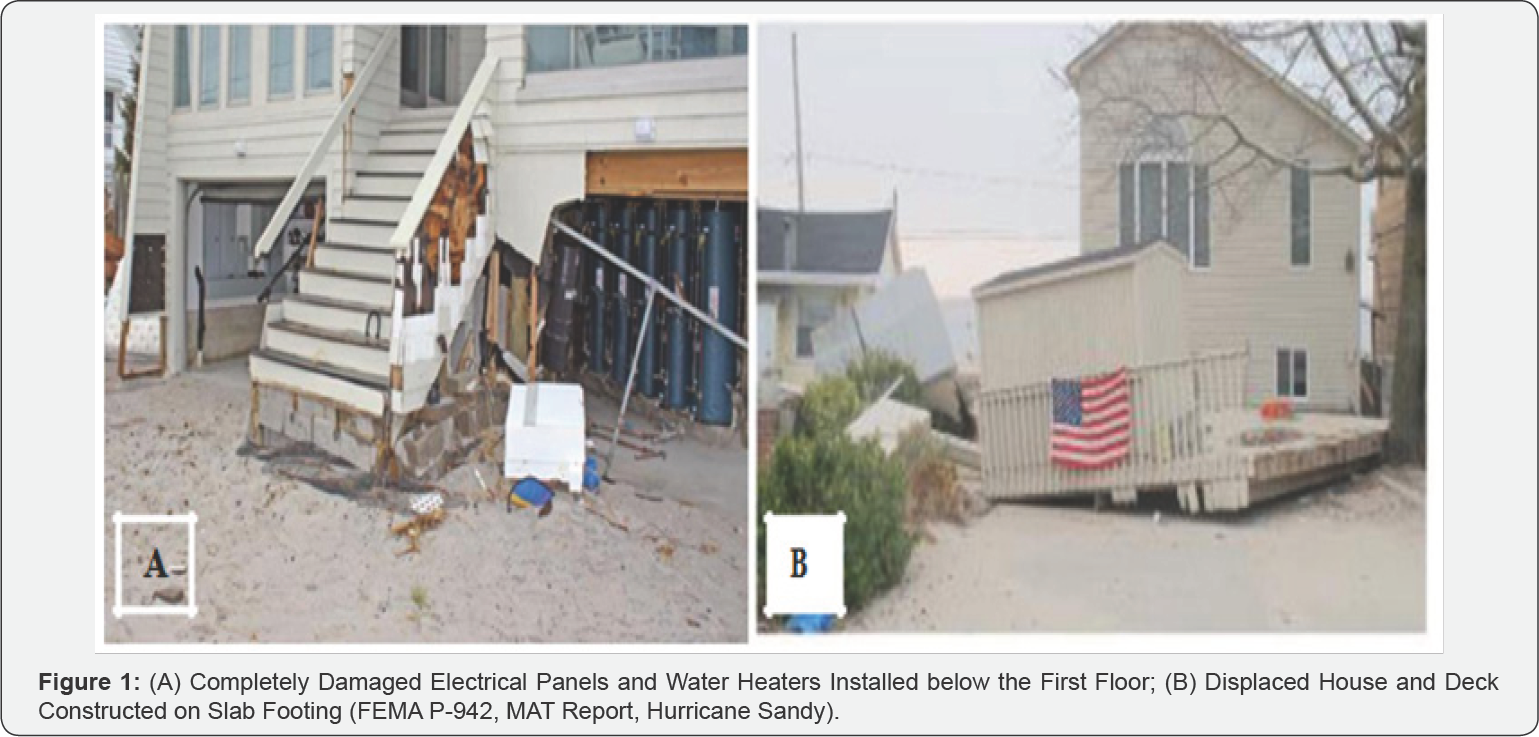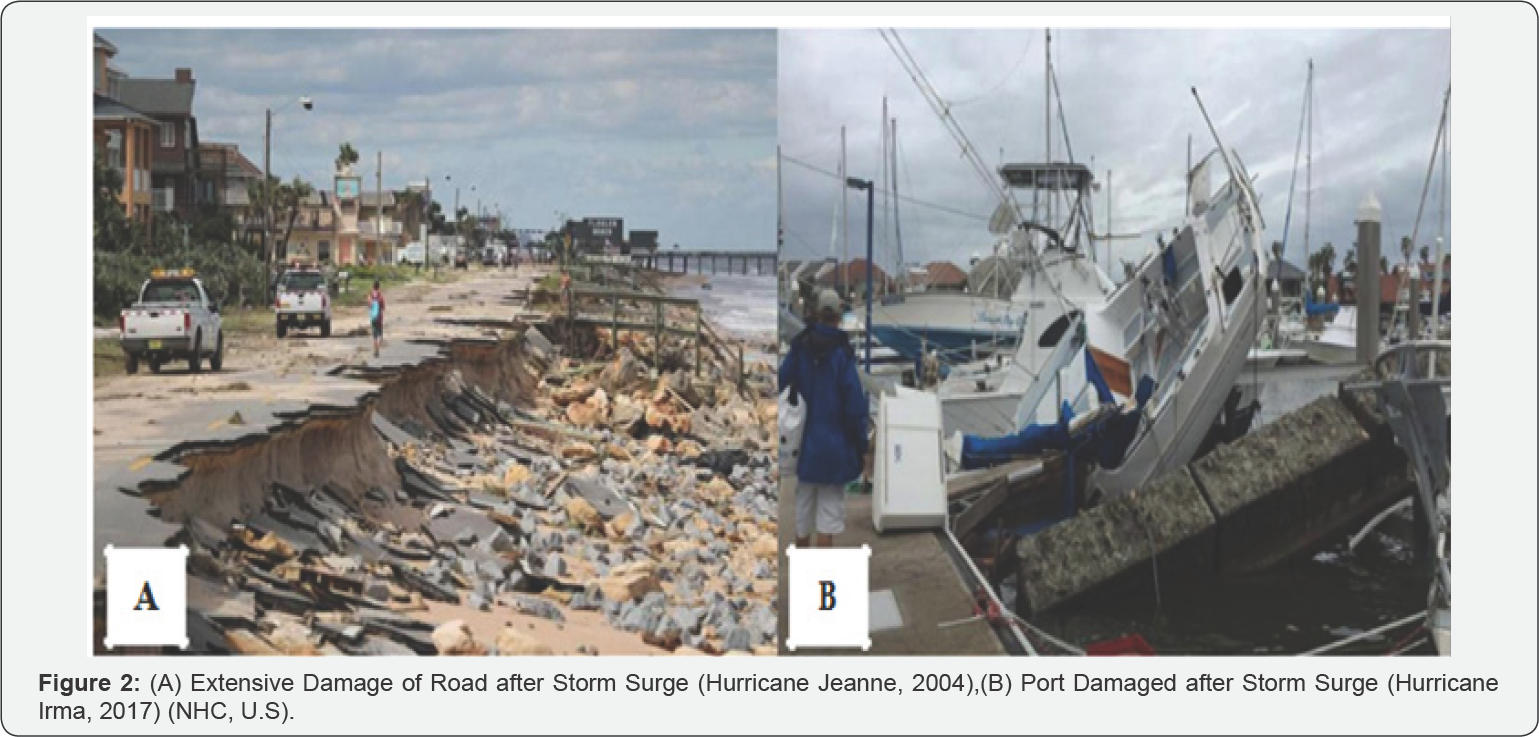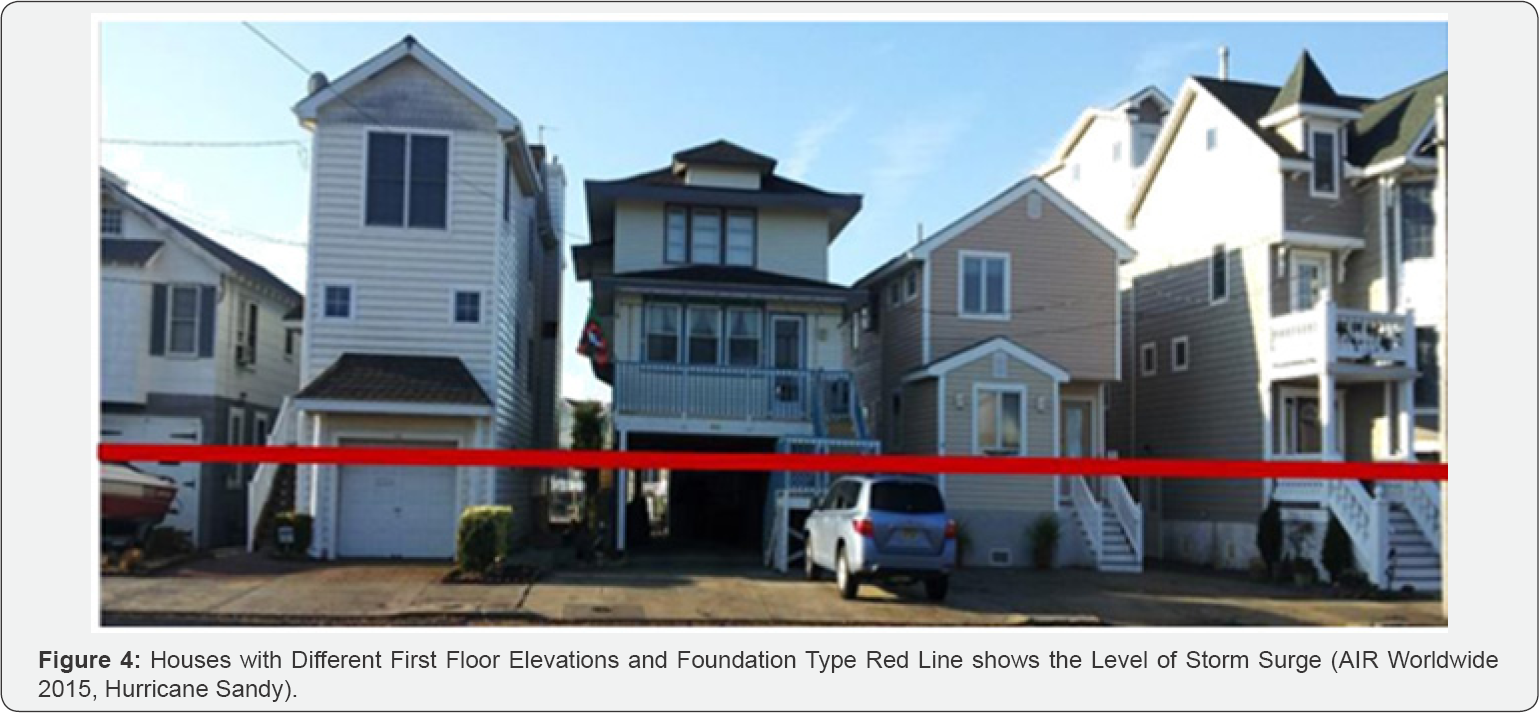Storm Surge and its Effect- A Review on Disaster Management in Coastal Areas- Juniper Publishers
Juniper Publishers- Journal of Civil Engineering
Abstract
Globally, about 1.2 billion people reside in coastal
areas presently, and this population scale is predicted to increase with
time. With increase in coastal population the chances of exposure to
storm surge is also increasing. Storm surge expose coastal areas and its
residents to risk of loss of life, fatal injuries, property damage etc.
Even though we cannot completely avoid the effect of this hazard, we
can reduce the effect of hazard by proper study on the area under
exposure and implementing a disaster management plan with adequate
preparedness and mitigation strategies. Thus coastal hazard management
has become an important aspect of coastal planning so as to develop the
resilience of society towards coastal hazards. Hard engineering
structures, soft protection measures, and managed retreat from the
coastline are some of the possible management options.
In this paper the study focus on the storm surge
phenomenon, its effects and risk on people, environment, engineering
structures and other infrastructure. It also covers the pre-disaster
phases of disaster management cycle that is the common preparedness and
mitigation strategies described along with incidents during past storm
surge disaster. All these aspects can improve the knowledge level of
people to take necessary actions at right time, thus enhancing the
capacity of the society to fight the hazard.
Keywords: Storm surge; Coastal hazard management; Disaster management cycle; Pre-disaster phases
Introduction
Coastal hazards like storm surge expose a coastal
area to risk of property damage, loss of life and environmental
degradation. The unexpected rise of the sea level most commonly
associated with a cyclone can cause significant flooding and cost people
their lives; the severity is affected by the shallowness and
orientation of the water body relative to storm path, as well as the
timing of tides. Storm surge is the main reason behind most of the
casualties during tropical cyclones.
While comparing itself with many other disasters, storm surge occurs
frequently due to strong storms in coastal regions. Compared to past,
occurrence rate of storm surge has increased drastically and the trend
is expected to continue in future as a consequence of climatic changes,
increase in world-wide sea levels, increase in temperature etc. In most
cases a hazard becomes a disaster due to human intervention; in the form
of residing practices, construction methods, and other activities like
encroachment, fishing industry etc. Since early civilisation, human
population finds coastal areas as the most suitable and attractive
settling grounds, as they provided abundant marine
resources, possibilities for livelihood in the form of trade and
transport etc. This view of population has eventually led to high
population densities and high level development in many coastal areas.
At present, about 1.2 billion people live in coastal areas globally, and
this number is predicted to increase to 1.8-5.2 billion by the 2080’s
due to a combination of population growth and coastal migration [1].Increase in coastal population, increases the chances of exposure. If coastal are not well protected and not timely informed about the evacuation needs and steps it can result to a huge disaster. As per records the deadliest storm surge recorded was the 1970 Bhola cyclone, which killed up to 500,000 people in the area of the Bay of Bengal [2].
We cannot completely avoid any hazard, but proper
study of the area under exposure and an adequate disaster management
plan. Thus coastal hazard management has become an important aspect of
coastal planning so as to develop the resilience of society towards
coastal hazards. Hard engineering structures, soft protection measures,
and managed retreat from the coastline are some of the possible
management options. This
review paper focuses on the risks of storm surge phenomenon
and its effects; paper also covers the pre-disaster phases of
disaster management cycle that is the effectiveness of common
mitigation and preparedness strategies.
Impact of Storm Surge
A storm surge can lead to extreme flooding in coastal areas,
causing property damage, loss of human life, coastal erosion,
change in ecosystem etc. The two most vulnerable areas during
storm surge are the estuaries and coastal areas. The severity of
a surge is impacted by the wind intensity, forward speed and
the angle of the approaching storm, the width and slope of the
continental shelf. Table 1 shows the level of damage of storm
surge followed by different categories of hurricanes and Table 2
shows impact of some of the past events [3]. The deadliest storm
surge on record was the 1970 Bhola cyclone, which killed up to
500,000 people in the area of the Bay of Bengal. Table 2 shows
list of death followed by various scenarios of storm surge [3].



Briefly, storm surge can cause damage to building foundation,
framing, finishing collapsing the entire stability of the structure.
Non-structural damage, like failure of MEP systems (depends
on the location), affecting the usability of the building are also
common during storm surge [4] (Figure 1).
In most cases transportation facilities like roads, railways,
bridges, ports, communication systems etc. (Figure 2) get
damaged delaying the response and recovery thereby making
disaster worse. Table 2 shows cost of property damage of certain
past storm surge events [3].

In some way or other environment is also vulnerable to such
natural hazard. Loss of soil fertility due to saltwater intrusion
not only affect the agricultural land but also makes changes in
the wetland ecosystems, turning them inhabitable for some
organisms. As Per the US Geological Survey after hurricanes
Katrina and Rita, about 560km2 of land was transformed to water
destroying the breeding grounds for marine mammals, brown
pelicans, turtles, and fish, and migratory species such as redhead
ducks [5]. The floodwater often carries toxic substances such
as heavy metals, ammonia, pesticides, untreated sewage and
phosphate. These substances cause problems like degradation
of water quality and decrease in dissolved oxygen, resulting in
dead organisms and can also often lead to epidemic disaster.
Hurricane Katrina caused oil spills from 44 facilities throughout
south eastern Louisiana, which resulted in over 26,000m3 of
oil being leaked. Most were contained on-site, though some oil
entered the ecosystem and residential areas [5]. After Murphy
Oil refinery spill, 1,800 homes were oiled in the towns of
Chalmette and Meraux. The flood waters that covered New
Orleans were pumped into Lake Pontchartrain, which took 43
days to complete [5].

Erosion of Beaches is another impact of storm surge. In
Case of Dauphin Island, Alabama (Figure 3), repeated attacks by
hurricane waves and surge have taken a toll on Island, carving
a breach in the narrow island, toppling beachfront homes, and
eroding large stretches of coast. The yellow arrow in each image
points to the same feature Error! Reference source not found.
Effectiveness of different types of Mitigation Measures
Hard engineering techniques
Hard coastal defensive structures are the most effective
option for surge mitigation and stabilizing shoreline at a fixed
position. Groins, Sea walls, Revetments, Breakwaters, Fixed
dams, Retaining walls are some protection structures used
commonly in developing countries due to its low instalment
and maintenance cost compared to higher technology option
like storm surge barriers which is effectively implemented
in developed countries. Some examples include, the Thames
movable barrier located in central London, prevents London
from being flooded by storm surges moving up from the North
Sea. It needs to be raised only during high tide and at ebb tide
it can be lowered to release the water that backs up behind it.
Movable barriers also require simultaneous investment in flood
warning systems to inform when to close the barrier. Number of
examples of effectively performed fixed structures like Sea walls,
Groins, Breakwaters is visible throughout different countries.
Apart from its merits, hard structures also have some price
to pay. It adversely influences the recreational use and ecological
matters within the coastal zone. For example, when seawalls
are constructed erosion of the beach in front of the seawall
continues to become very narrow to completely disappear later.
In case of groins, when it traps sediment on the up drift side,
there is corresponding shoreline erosion on the down drift side
because of the interruption in longshore transport.
Soft engineering techniques
Soft coast measures make use of environmental friendly
techniques to achieve the same objective of hard defence
structures. Soft techniques aims in achieving a balance between
the need for protection against erosion while maintaining and
enhancing shoreline functions. It includes developing a natural
shoreline, mangrove forest, bioengineered seawalls, Geotubes,
Beach replenishment etc. Even though in most cases they are
considered to be temporary defence structure with a fair amount
of success, the long term goal of the planners is to develop soft
coast so that we can completely abandon the hard structures [6].
As per UNEP during Tsunami 2004, it was natural defence
structures who performed well compared to engineered
structures. After storm surge in Orissa state (India) October
2009, a study in Kendrapada District [409 villages], indicated
that 1.72 additional deaths per village within 10km of the coast
were avoided due to the existence of Mangrove forest from
30,766 ha to 17,900 hectare .Similarly for same event the loss of
US$33.31 was observed in Bankual village which was protected
by Mangrove Ecosystem Wildlife Sanctuary (145km2) compared
to Bandhamal village protected by embankments with a loss of
US$153.7 [7].
Building Practices

Foundation type and first floor elevation are the main
determinants of a residential building’s vulnerability. Buildings
with an elevated first floor are found to be less vulnerable to
damage compared to buildings with the first floor on street
level; however buildings with an elevated first floor could still
sustain significant damage, depending on the foundation type
[4] (Figure 4).
Main two types of foundations are the closed and open
foundation:Closed foundation walls create large obstructions
to hydrodynamic loads associated with moving water, thus
closed foundations are also more vulnerable to scour than
open foundations. Figure 5 shows a successful pile foundation
following Hurricane Katrina (Dauphin Island, Alabama).

Managed retreat and controlled construction practices
Congested construction practices near coastal area is a
major threat during storm surge as it will increase the exposure
and slow down the evacuation process. Case of Bay of Bengal
where thousands of people killed in the overpopulated coastal
regions during series of cyclones events is the best example for
uncontrolled coastal construction disaster. Managed retreat is a
non-structural measures were a certain area is cleared for surge
flooding is a good choice of mitigation measure. Managed Retreat
of Pacifica State Beach in 2005 become a success with reduction
of flood hazards, increase in functioning wetland habitat, and
expanded recreation opportunities [8].
Challenges in Implementation of Mitigation Measures
The high cost and the requirement for specialist knowledge
in the design and implementation phases may prove a barrier
to implementation of hard engineering structures like Storm
surge barriers. For structures like Seawall, Break water etc.
availability of suitable material, space transportation of this
building material to location etc. is a major challenge. All type
of engineered structure face challenge of periodic maintenance.
Case of villages of Kerala in Ernakulam district affected during
event of Ockhi cyclone (December, 2017) is an example for lack
of periodic maintenance of existing Seawall.
In case of Soft engineering structures, extreme events with
very high water levels and wind speeds may severely damage
or destroy mangrove areas, vegetation etc. making them less
effective and time taken for its natural recovery act as another
challenge.
Since construction of elevated structure is more costly
compared to non- elevated, Residents are unwilling for such
practice making them in danger.
Attitude of coastal community to settle in storm surge prone
area neglecting danger due to congestion and exposure is a
major challenge for managed retreat project.
Community Preparations for Storm Surge Event
Preparedness is one of the most important pre-disaster
phase of disaster management cycle which aims not only in
increasing the community resilience (capacity to face a disaster),
but also focus on the sustainable development of the community.
In case of most of the disaster events more than 90 percentage
of fund is used for post-disaster phase, if more care is provided
in pre-disaster phase it will eventually reduce the expense for
recovery.
Early forecasting and warning system
Early warning is a major element of disaster risk reduction.
Early action often prevent a hazard turning into a human disaster,
warning provides people enough time to implement the action
plan. One of the main reason behind the pathetic condition in
Kerala during Ockhi Cyclone (December, 2017) was the absence
of an early warning. People were unaware of the occurrence
cyclone or the surge followed by it.
Educating people at risk
Coastal residents can be empowered by giving proper
education regarding the storm surge impacts, actions to be
taken, 72 hour disaster kit etc. It also helps in keeping themselves
alive until rescue arrives. In case of Myanmar (Cyclone Nargis,
2008) it was found that damages (138,000 fatalities) became
worse not only due to improper evacuation plan but also due to
lack of perception of threat of storm surge and residents fewer
experiences of storm surge, because of which people didn’t
get any image of the possible disasters when the storm surge
came. This is a clear example for lack of proper education among
coastal people [9].
Evacuation Plan in case of emergency
An evacuation plan lays out how to escape safely from the
vicinity of disaster prone area to rescue shelters during an
emergency. It involves activities like provision of transportation
and communication facilities, opening shelters, rescue & relief
etc. The entire action plan developed will be executed response
phase. During Storm Surge by Cyclone Sidr in Bangladesh
(2007) absence of evacuation information along with lengthy
evacuation distance to shelters made the situation worse since
people were washed away before reaching the shelter and some
of them were trapped inside the houses as they couldn’t open
the doors and windows due to flooding. There are some other
cases like Storm surge (2012) due to hurricane Sandy in New
York which caused widespread devastation to infrastructure like
electricity and subway system. But unlike other failure cases, for
a highly urbanized area of New York ,since subway system was
stopped before storm and residents in highly flood prone area
was evacuated immediately before flooding further personal
loss was prevented [10-15].
Conclusion
Compared to other natural disasters storm surge is a hazard
which occurs frequently due to strong storms in coastal areas.
In most cases storm surge becomes a disaster when they occur
unexpectedly without proper preparations and any preventive
measures Storm surge not only has inverse impact on human
life but also the environment, animals, infrastructural facilities,
structures etc. All of them are in one way or another vulnerable
to the hazard [16].
History of past events shows us that the money spend for
post disaster management phases of response and recovery is
higher ,the reason behind such a situation is due to the lack of
importance given to the pre-disaster management phases that is
the preparation and mitigation phases. Since prevention is said
to be always better than cure, if proper care and importance is
given for the strategies before any hazard ,then we can not only
reduce the effect but can also prevent the expenditure during the
post disaster periods [17-19].
Common structural and non-structural preventive measures
that can be opted for storm surge event include engineered
structures like sea walls, storm surge barrios, closure dams,
natural defence structures like mangrove forest, proper building
practices etc. Even though in most cases hard engineering
structures are found to be more effective than soft engineered
and non-structural measures, it is always better to go for environmental friendly techniques and all present studies are
looking forward to Soft coast rather than a Hard coast. The
importance of effectiveness of Preparation techniques like
provision of early warning system, 72 hour disaster kit,
evacuation plan etc. is another important factor, which is clear
from the examples already discussed in this paper. All these
management techniques seek the assistance from government
for establishment, but some of the preparation techniques can
be achieved without outside assistance such as use of sand bags,
coastal vegetation, proper construction materials and practices,
provision of drainage, periodic maintenance of individual
buildings etc. These kind of study helps to increase the resilience
of community to fight the hazard in all possible, so as to ensure
the safety and sustainability of the people.
For More Open Access Journals Please Click on: Juniper Publishers
Fore More Articles Please Visit: Civil Engineering Research Journal


Comments
Post a Comment